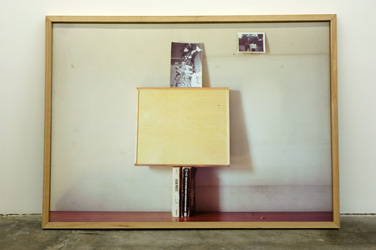Leslie Hewitt, Make It Plain (2 of 5), 2006.
Born 1977 in New York, New York; lives in New York, New York, and Houston, Texas
Leslie Hewitt is inspired by “the everyday and the transformative power of circumstance or situation,” as she notes in Modern Painters, taking on the forsaken documents of our past—brittle pictures, forgotten books, repressed films, and ephemera—to repurpose them in the present. Influenced by the ethics of Third Cinema and the potential and limits of the photographic as a tool for discourse, Hewitt renders the aesthetic and the conceptual inextricable. Her photosculptural works not only retrieve memory but question the very basis of our access to it: how it is mediated, reframed, and changed through the contingencies of space and the exigencies of time.
For her series of ten chromogenic prints Riffs on Real Time (2002–05), Hewitt rephotographed intimate family pictures she had collaged on grounds of handwritten letters, magazines, and vocabulary primers, which were in turn placed on wooden planks, shag carpets, and other fundamentally domestic grounds. In their reorientation from floor-bound assemblages to wall-mounted photographs and as the layers of history accumulate, these objects accrue personal and collective significance, yet the pictures also pointedly reflect on the camera’s role— and limitations—in constructing meaning.
The objectlike materiality of images—their texture, heft, and scale—is further examined in the two series shown in her 2006 exhibition at LAXART in Los Angeles. Propped almost sculpturally against the wall, the billboard-size photographs constituting Make It Plain (2006) depict old snapshots and books including the 1968 Kerner Report on urban riots and, published the same year, Joanne Grant’s Black Protest arranged around an empty, flattened rectangular structure. In Ready to Battle (2006), large black-and-white ink drawings of objects of adornment (earrings, a hair pick, pomade) are pinned to the gallery wall alongside related drawings nestled in wooden drawers on the floor. Here Hewitt insists that even these most personal artifacts are not exclusive in significance, but open for public debate.
Hewitt’s collaboration with William Cordova, I Wish It Were True (2004– ), gains meaning as an act of collaboration between artists and community (see Cordova entry). Earlier, as students at Yale, they had sought to redress a deficiency in the institution’s collection of revolutionary-themed films by amassing what they describe in Houston Review as “an evolving archive of our collection of bootleg independent/ alternative films central to representing Black and Latino consciousness within the canon of cinema.” They developed this concept for Houston’s Project Row Houses, reconstructing a monolith-inspired phalanx of some eight hundred VHS tapes and a rudimentary screening room—a social sculpture attuned to its context and audience. As Hewitt suggests in this and other works, these are not just images to be looked at: in their mobility and allowance for agency, their ideas can be put to critical use. SUZANNE HUDSON
Leslie Hewitt, Make It Plain (2 of 5), 2006. Digital chromogenic print in custom ash-wood frame, unglazed, 60 x 84 in. (152.4 x 213.4 cm). Collection of the artist.
























